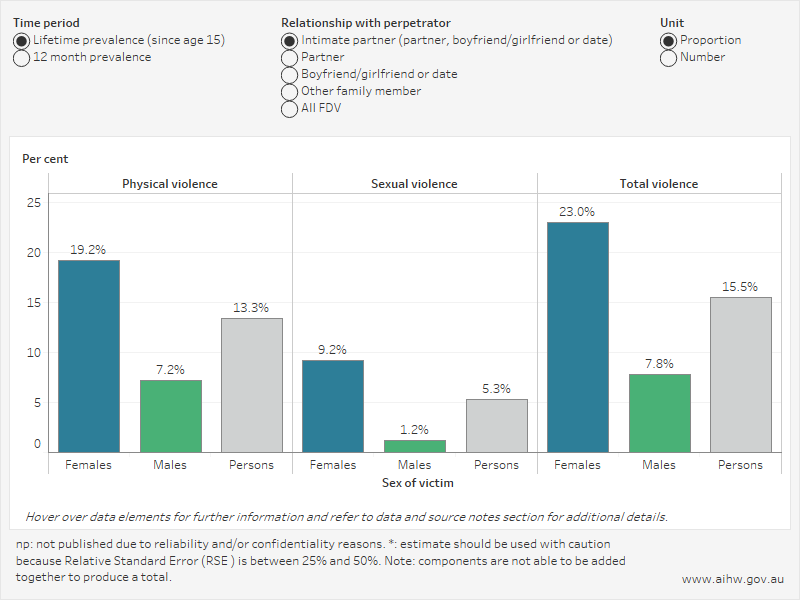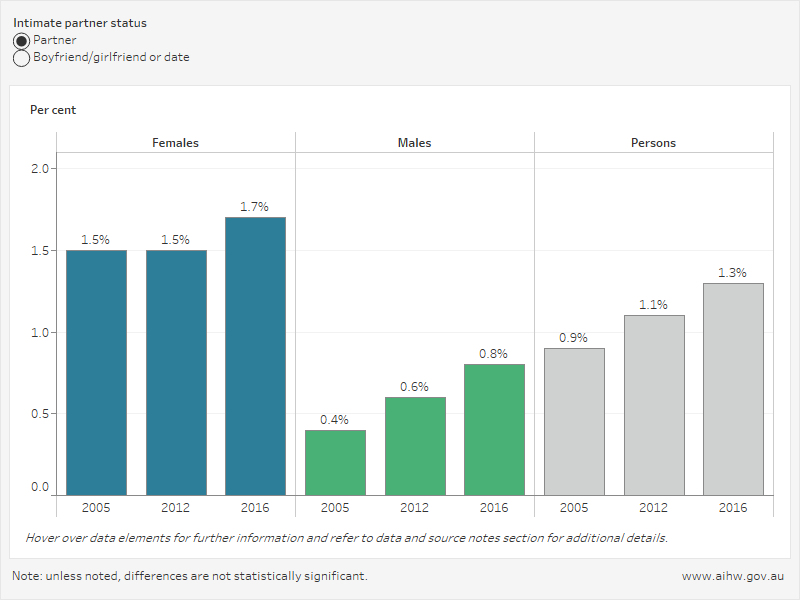Physical and/or sexual family and domestic violence
Understanding the nature and prevalence of family and domestic violence can inform the development and evaluation of policies, programs and services to prevent and better respond to the issue. While every experience is very personal and different, it is most common for this type of violence to be perpetrated against women, by men. Data on the prevalence of physical and/or sexual family and domestic violence in Australia is available from the ABS Personal Safety Survey (PSS) which collects information on the experiences of violence for women and men in Australia.
The visualisation below allows users to explore the estimate and proportion of Australians aged 18 and over who have experienced physical and/or sexual family and/or domestic violence at least once since the age of 15 (lifetime prevalence), and at least once in the last 12 months (12 month prevalence), by sex of victim, and relationship with perpetrator. Across all family and domestic relationship types in 2016, a higher proportion of women than men experienced physical and/or sexual violence at least once in their lifetime. Almost 1 in 4 (23% or 2.2 million) women and 1 in 13 (7.8% or 704,000) men experienced physical and/or sexual violence by an intimate partner at least once since the age of 15. An estimated 2.3% (or 212,000) of women and 1.3% (or 114,000) of men experienced physical and/or sexual intimate partner violence at least once in the last 12 months.
Prevalence of physical and/or sexual family and domestic violence, by sex, 2016

Time series
The most common instances of family violence occur in intimate partner relationships. Examining the prevalence of intimate partner violence over time can help to identify patterns in violence and evaluate the possible impact of changes in policy and programs.
The visualisation below shows the proportion of Australians aged 18 and over, who have experienced violence by an intimate partner in the 12 months prior to the survey, by sex and type of intimate partner at three time points. There was no statistically significant change over time, for either sex and/or partner type.
Proportion of people who have experienced intimate partner violence in the last 12 months, by sex, 2005, 2012 and 2016

Population groups
Examining the prevalence of family and domestic violence across different population groups can help to identify those groups at higher risk. This information can be used to inform the development of more targeted programs and services for victims and perpetrators of family and domestic violence. Of particular interest, are the differences between population groups for violence between partners.
The visualisation below shows the estimated number and proportion of people aged 18 and over, by sex, in different population groups who have experienced different types of violence by a current or previous partner in the 12 months prior to the survey. It shows that in 2016:
- people aged 25–34 were more likely to experience physical and/or sexual partner violence in the previous 12 months compared to the all ages total.
- people with disability were more likely to experience physical and/or sexual partner violence in the last 12 months than those without disability.
12 month prevalence of partner violence, by population group and sex, 2016
Notes
- Family and domestic violence is defined as any violence that occurs where the relationship of respondent to perpetrator in the PSS is: Current or Previous partner; Father or Mother; Son or Daughter; Brother or Sister; Other relative or in-law; Boyfriend, Girlfriend or date; Ex-boyfriend or Ex-girlfriend.
- The PSS defines partner as a person the respondent lives with, or lived with at some point in a married or de facto relationship. A current partner is a person who, at the time of the survey, was living with the respondent in a marriage or de-facto relationship, and a previous partner is a person who lived with the respondent at some point in a marriage or de facto relationship, but who was no longer living with the respondent at the time of the survey.
- The PSS defines an intimate partner as a person who is either the Current or Previous partner; Boyfriend, Girlfriend or date; or Ex-boyfriend or Ex-girlfriend of the respondent.
-
Physical violence includes both physical assault and physical threat as defined by the PSS.
-
The PSS defines physical assault as an act that involved the use of physical force with the intent to harm or frighten a person. Behaviours can include slaps, hits, punches, being pushed down stairs or across a room, choking and burns, as well as the use of knives, firearms and other weapons.
-
The PSS defines physical threat as the threat of acts of a physical nature that were made face-to-face where the person believed it was able to and likely to be carried out.
-
Sexual violence includes both sexual assault and sexual threat as defined by the PSS.
-
The PSS defines sexual assault as an act of a sexual nature carried out against a person's will through the use of physical force, intimidation or coercion, including any attempts to do this. This includes rape, attempted rape, aggravated sexual assault (assault with a weapon), indecent assault, penetration by objects, forced sexual activity that did not end in penetration and attempts to force a person into sexual activity. Incidents so defined would be an offence under State and Territory criminal law.
-
The PSS defines sexual threat as the threat of acts of a sexual nature that were made face-to-face where the person believed it was able to and likely to be carried out.
-
Separate sexual and physical violence counts are not able to be added together to produce a total. Where a person has experienced both sexual and physical violence, they are counted separately for each type of violence they experienced but are counted only once in the aggregated total.
- The PSS states that a disability or restrictive long-term health condition exists if a limitation, restriction, impairment, disease or disorder has lasted, or is expected to last for six months or more, which restricts everyday activities.
-
The PSS collects information from women and men aged 18 years and over.
-
Survey data, obtained from a sample of the population, is subject to sampling error. Where estimates are subject to a level of sampling error too high for general use, they are not included in visualisations, but are included in data tables, with caveats.
-
The observed value of a rate may vary due to chance even where there is no variation in the underlying value of the rate. The margin of error is the largest possible difference (due to sampling error) that could exist between the estimate and what would have been produced had all persons been included in the survey. Confidence intervals—constructed by taking the estimate plus or minus the MoE— can be used to provide an approximate indication of the true differences between rates. If the confidence intervals do not overlap, the difference can be said to be statistically significant. However, statistically significant differences are not necessarily the same as differences considered to be of practical importance. Small differences that have practical importance may be found to be not statistically significant as they are below the threshold the significance test can reliably detect.
-
Changes over time may indicate a change in the underlying rate of violence, a change in the propensity to report this violence, or both.
-
For more information see Methods, Glossary and Data sources.
Sources
ABS 2016 Personal Safety Survey
Next expected: 2022



